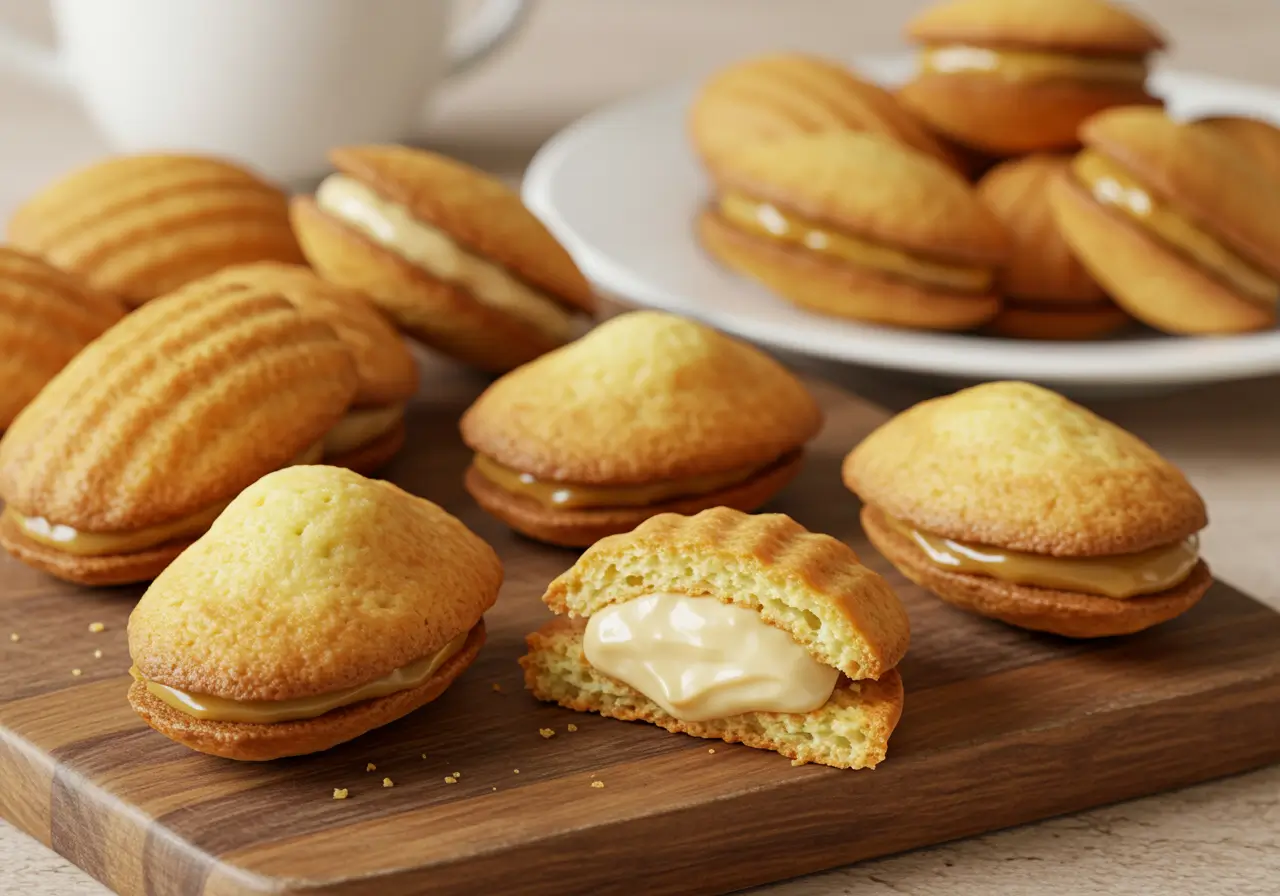Madeleine Cookies Recipe Using Cream
The first time I bit into a perfectly baked madeleine cookie, I was transported to a quaint Parisian café. There’s something magical about these delicate, shell-shaped treats that captures both the heart and palate. But today, I’m sharing something even more special – a madeleine cookies recipe using cream that elevates this classic French pastry to new heights of indulgence.
In this comprehensive guide, you’ll discover not only how to make these exquisite cream-enriched madeleines but also understand the science behind what makes them so irresistible. Whether you’re a seasoned baker or trying madeleines for the first time, this recipe promises results that will impress even the most discerning palate.
Table of Contents
What Are Madeleine Cookies? (A Brief History)
Madeleine cookies are small, shell-shaped sponge cakes that originated in northeastern France in the 18th century. According to popular legend, they were named after a young cook named Madeleine who served them to King Louis XV at the Palace of Versailles. The king was so impressed that he named the cookies after her.
What truly sets madeleines apart is their distinctive scalloped shell shape, created using special madeleine pans. This unique shape isn’t just aesthetically pleasing – it allows the edges to crisp perfectly while maintaining a tender interior. Traditional madeleines feature a characteristic “hump” on the back, a sign of proper preparation and baking technique.
Why Cream in Madeleine Cookies? (The Science)
Adding cream to madeleine cookies isn’t just a flavor preference – it’s a game-changer that transforms both taste and texture through several scientific principles:
Taste Enhancement
Cream brings a rich, buttery flavor dimension that elevates the subtle vanilla and lemon notes traditionally found in madeleines. The higher fat content in cream contributes to a more complex flavor profile that lingers pleasantly on the palate.
Texture Revolution
The proteins and fat in cream create a more tender crumb structure. When incorporated into the batter, cream’s fat molecules coat the flour proteins, limiting gluten development and resulting in a softer, more delicate texture than traditional butter-only recipes.
Moisture Magic
Cream’s higher water content (compared to butter alone) increases the overall moisture in the batter. This produces madeleines that stay fresh longer and maintain their soft interior even days after baking.
Fat Content Factors
Different creams affect the final product in unique ways:
- Heavy cream (36-40% fat): Creates the richest, most tender madeleines
- Whipping cream (30-35% fat): Offers excellent results with slightly less richness
- Light cream (18-30% fat): Produces lighter madeleines with more subtle dairy notes
- Half-and-half (10-18% fat): Gives a gentle cream flavor with less overall richness
Alternative Creams
For those with dietary restrictions:
- Coconut cream: Offers a tropical twist while maintaining richness for dairy-free diets
- Cashew cream: Provides excellent fat content with a neutral flavor profile
- Oat cream: Creates a slightly nuttier flavor with good moisture retention
- Soy cream: Works well with minimal flavor alteration from the original
The Ultimate Madeleine Cookies Recipe Using Cream
Ingredients List

| Ingredient | Amount (US) | Amount (Metric) |
|---|---|---|
| All-purpose flour | 1 cup | 120g |
| Granulated sugar | ½ cup | 100g |
| Heavy cream | ¼ cup | 60ml |
| Unsalted butter | ½ cup (1 stick) | 113g |
| Eggs | 2 large | 2 large |
| Honey | 1 tablespoon | 15ml |
| Vanilla extract | 1 teaspoon | 5ml |
| Lemon zest | 1 teaspoon | 5g |
| Baking powder | ½ teaspoon | 2g |
| Salt | ¼ teaspoon | 1g |
Note: For best results, use the highest quality ingredients available. Farm-fresh eggs and high-fat content European-style butter will significantly enhance your madeleines.
Step-by-Step Instructions
- Prepare the butter: Melt the butter in a small saucepan over low heat. Once melted, remove from heat and let cool slightly while preparing the other ingredients.
- Mix dry ingredients: In a medium bowl, whisk together the flour, baking powder, and salt. Set aside.
- Beat eggs and sugar: In a large mixing bowl, beat the eggs and sugar with an electric mixer on medium-high speed for about 5 minutes until the mixture becomes pale, thick, and forms ribbons when the beater is lifted.
- Add flavor elements: Gently fold in the honey, vanilla extract, and lemon zest into the egg mixture.
- Incorporate dry ingredients: Sift the flour mixture over the egg mixture and fold in gently with a spatula until just combined. Be careful not to overmix.
- Add cream and butter: Pour the heavy cream into the batter and fold until incorporated. Then gradually add the melted butter, folding until completely integrated into the batter.
- Rest the batter: Cover the bowl with plastic wrap and refrigerate for at least 2 hours, or preferably overnight. This resting period is crucial for developing the iconic madeleine “hump.”
- Prepare for baking: Preheat your oven to 375°F (190°C). Thoroughly butter and flour a madeleine pan, tapping out excess flour.
- Fill the molds: Remove the batter from the refrigerator. Using a spoon or piping bag, fill each madeleine mold about ¾ full. Don’t spread the batter – it will spread naturally during baking.
- Bake to perfection: Bake for 10-12 minutes until the edges are golden brown and the centers spring back when lightly touched. The iconic hump should form during the first 5-7 minutes of baking.
- Cool and release: Allow the madeleines to cool in the pan for 2 minutes before gently removing them. If they stick, tap the edge of the pan lightly or use the tip of a knife to loosen them.
Baking Time and Temperature
- Standard home oven: 375°F (190°C) for 10-12 minutes
- Convection oven: Reduce to 350°F (175°C) for 8-10 minutes
- Gas oven: Use middle rack at 375°F (190°C) for 10-12 minutes
Your madeleines are done when the edges are golden brown, the center springs back when touched, and a toothpick inserted comes out clean. For perfect madeleines, watch carefully during the last few minutes of baking as they can quickly go from perfectly golden to overdone.
Variations on the Recipe

Lemon Madeleines with Cream
Increase the lemon zest to 1 tablespoon and add 1 teaspoon of fresh lemon juice to the batter. After baking, you can brush with a simple lemon glaze made from powdered sugar and lemon juice.
Chocolate Madeleines with Cream
Replace 2 tablespoons of flour with unsweetened cocoa powder. Add ½ teaspoon of espresso powder to enhance the chocolate flavor. For extra indulgence, fold in ¼ cup of mini chocolate chips before chilling the batter.
Orange-Cardamom Madeleines
Substitute orange zest for lemon zest and add ¼ teaspoon of ground cardamom to the dry ingredients for an exotic twist.
Gluten-Free Madeleines with Cream
Replace all-purpose flour with a high-quality gluten-free flour blend that contains xanthan gum. Add an extra egg yolk to help with binding and structure.
Vegan Madeleines
Substitute the heavy cream with coconut cream, use plant-based butter, and replace eggs with a mixture of aquafaba (the liquid from a can of chickpeas) whipped with a pinch of cream of tartar.
Troubleshooting Guide
| Problem | Possible Cause | Solution |
|---|---|---|
| Flat madeleines (no hump) | Batter not properly chilled or overmixed | Chill batter at least 2 hours; fold ingredients gently |
| Madeleines not browning | Oven temperature too low | Calibrate oven; increase temperature slightly |
| Sticking to the pan | Pan not properly greased and floured | Use butter (not spray) and dust thoroughly with flour |
| Dense texture | Overmixing or improper measuring | Fold gently; weigh ingredients for accuracy |
Why Don’t I Have a Hump?
The iconic madeleine hump forms due to the temperature shock between cold batter and hot oven. Ensure your batter is properly chilled and your oven is fully preheated. Starting with a slightly higher temperature (400°F) for the first 2 minutes, then reducing to 375°F can also help create that perfect hump.
Tips for Perfect Madeleines
- Chilling is non-negotiable: The minimum chill time is 2 hours, but overnight delivers the best results. This relaxes the gluten, allows flavors to meld, and ensures the characteristic hump.
- Pan preparation matters: Traditional metal madeleine pans conduct heat best. Brush every ridge with melted butter, then dust with flour or fine sugar for easy release and perfect definition.
- Batter consistency: The properly mixed batter should fall from a spoon in a thick ribbon. If it’s too stiff after chilling, let it stand at room temperature for 5-10 minutes.
- Gentle technique: Fold ingredients rather than stirring to maintain air in the batter. Overmixing develops gluten, resulting in tough madeleines.
- Temperature shock: Place the chilled batter directly into a hot oven. This temperature difference triggers the steam that creates the characteristic hump.
Serving Suggestions
Madeleines made with cream are best enjoyed within a few hours of baking when they’re still slightly warm. Their buttery, tender quality pairs beautifully with:
- Traditional: Serve with tea or coffee – the French classic is dipping madeleines in café au lait
- Elevated: Dust with powdered sugar or drizzle with honey
- Decadent: Dip half of each madeleine in tempered chocolate and sprinkle with crushed pistachios
- Seasonal: Serve alongside fresh berries and crème fraîche
- Dessert: Use as the base for a sophisticated shortcake with whipped cream and fruit
Storage Instructions
Store cooled madeleines in an airtight container at room temperature for up to 2 days. For longer storage, freeze in a single layer, then transfer to a freezer bag for up to 1 month. Thaw at room temperature and warm briefly in a 300°F oven for 3-5 minutes to refresh.
Conclusion
This madeleine cookies recipe using cream transforms an already beloved classic into something truly exceptional. The addition of cream creates a more tender, moist, and flavorful cookie that will have everyone asking for your secret.
Remember that making perfect madeleines is part science, part art – your technique will improve with each batch. Don’t be discouraged if your first attempt isn’t perfect; even slightly imperfect madeleines are delicious!
Happy baking!
Did You Try Our Recipe?
There are no reviews yet. Be the first one to write one.

